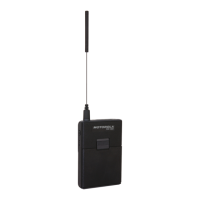• Call-related DGNA.
• Functionality of the authorized user.
• Network authentication before accepting DGNA.
Ambience Listening
The Ambience Listening (AL) feature allows a console operator or dispatcher to monitor audio activity in the vicinity
of a specific radio without giving any indication to the affected radio.
When the radio receives a call setup message with an AL call, the radio accepts the call. Then the radio opens the
microphone, and begins transmitting without showing any indication of the call. Call acceptance and rejection while
active in another call follows the PPC rules.
The radio imposes no time limit on the transmission. The radio continues to transmit until the SwMI ends the call or
the user performs an action that releases the call. If the user attempts to start a service while the AL call is in progress,
the radio disconnects the call and initiates the requested service. The radio allows performing actions that can be
performed without releasing the AL call. These actions include access of most menu items, activating, deactivating
scan lists, and changing talkgroups. When changing talkgroups, the radio appears as if it is performing an attachment.
The attachment appears to be successful, but the actual attachment signaling is performed only after the AL call
terminates. When performing the attachment after the call, no indication is shown to the user unless the attachment
fails. If you attempt to power down the radio in the active Ambience Listening call, the radio enters Pseudo Power-
Off state.
Preemptive Priority Call
If during a call, a call setup is received for a call with higher priority than the present call, and the new call priority is
Preemptive Priority 3 (value 14 in the codeplug) or Preemptive Priority 4 – Emergency (15), the radio disconnects
from the present call and joins the new high priority call.
If the call priority of the new call is Preemptive Priority 1 (12) or Preemptive Priority 2 (13), depending on
configuration the radio either accepts or rejects the new call.
When the new call is accepted, a special tone is played, and you are notified of the high priority call.
Transmit Inhibit Mode
The Transmit Inhibit Mode is a mode in which the radio sends no radio transmissions. It is recommended to activate
the mode in RF sensitive areas, for example hospitals, airplanes, where safety can be jeopardized due to transmission
radiation.
In this mode, the radio does not transmit under any circumstances except for the Emergency Calls. All the functions
and keys which cause transmission, for example registration to the network, changing talkgroup or folder, or pressing
the PTT button are disabled. Any transmission trial causes the radio to play a tone.
When no danger to safety exists anymore (for example, you leave the RF sensitive area), you can deactivate the
Transmit Inhibit Mode and the radio returns to standard operation.
You can deactivate the mode by using the OPTION button or implicitly when initiating an Emergency Call.
The Transmit Inhibit Mode is deactivated automatically, when you turn the radio off.
Note: RF Transmissions from the radio are prevented under the following conditions:
• TXI Mode is activated.
• Battery is removed.
• The radio is turned off.
On entering or exiting the transmit inhibit mode, when the radio is camped on a cell, it sends a specially designated
SDS status message. This SDS message indicates to the SwMI that the radio is entering or exiting transmit inhibit
mode.
44 | Services and Features
Send Feedback | |

